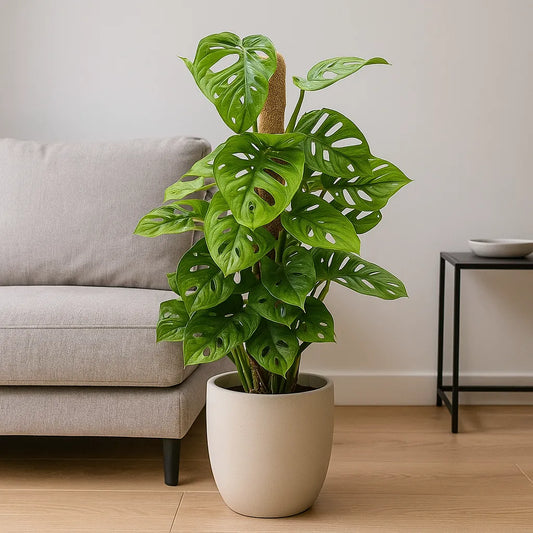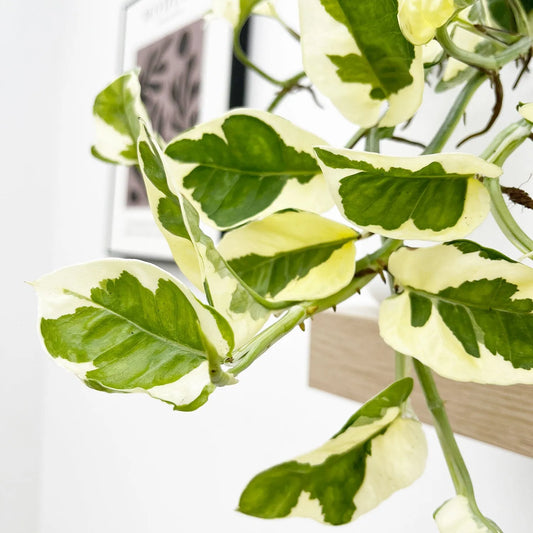How to keep houseplants alive over winter
As the weather gets colder and the temperature drops inside our homes, many plant owners are worried about how they’re going to keep their house plants alive during the winter months.
There’s no doubt that winter can be a challenging time for house plants. The light levels are low, temperatures are low and so are humidity levels. Unfortunately, these are all of the things our house plants need to survive and thrive!
As we move from the warmer months into the winter, how can we help our house plants and give them the best chance of making it through the winter, ready to grow again in the spring?
Here’s a guide to help you understand what your plants need during the winter and how you can help them.
Do house plants go dormant in winter?
Firstly, let’s take a look at whether house plants really go dormant in the winter. The answer is that some do and some don’t. It all depends on the conditions in your home and each individual plant.
There’s no doubt that your house plant’s rate of growth will significantly slow down but this doesn’t mean you’ll be able to ignore them until the spring. You’ll still need to provide them with care to make sure they’re able to make it through.
The winter can be a stressful time for your house plants so providing them with a helping hand to make sure they get what they need and not adding extra stress by repotting or moving them will make sure you’ve still got plants to enjoy in the spring.
1. Keep your house plants warm
Most house plants, especially the tropical varieties are extremely sensitive to cold air. To help your house plants survive, it’s important to protect them from cold air by sealing up your windows and doors as much as possible. This will help to prevent cold draughts and help your plants to stay as warm as possible.
If you keep your house plants near outside doors or on window sills in the warmer months, you might was to move them into other rooms where they’ll be better protected from cold air.
As well as keeping your house plants warm, you’ll also need to prevent them from being too warm! Move them away from heat sources such as fireplaces and radiators as the blasts of warm air from these sources can be just as damaging to your plants as cold air.
Try to maintain a temperature of between 18-24℃ during the day and keep temperatures above 10℃ at night to prevent plants from becoming too cold.
2. Make sure your plants get plenty of light
During the darker months when sunlight is rare, your plants need to be able to get as much of it as possible. They need light more than anything else in the winter.
Put them in a room where they’re going to get as much light as possible and make sure you rotate them every now and again to make sure they get as much sunlight as possible.
If you’re not sure whether your plants are getting enough light, there are a few common signs to look out for including:
-
Slow growth (despite growth being slower in the winter)
-
Pale or small leaves
-
Leggy growth
-
Leaning excessively towards the sun
To help them get as much light as they can, make sure your windows are clean so that the light can filter through properly!
3. Clean your plant’s leaves
With light being in short supply, it’s important to make sure your plants can take advantage of the little light that’s available. You can help them do this by making sure their leaves are clean and dust free.
You can either give the leaves a wipe down with a damp cloth or towel to get rid of dust and grime. If you want to go one step further, you can put your plants in the bath or shower and use a handheld sprayer to give them a wash.
4. Don’t water too much
The growth of your house plants will slow down in the winter as a result of the lower light conditions and this lack of light leads to a lack of growth. If your plant’s are not growing as much, they’re not going to need as much water or fertiliser.
As you would during the summer months, we recommend that you only water your house plants if the soil is dry an inch or two below the surface. This is a good indicator at any time of the year but, in the summer you’ll probably follow a regular watering schedule - in the winter you will find the soil becomes dry much less often.
Particularly in the winter, it’s important to make sure your house plants don’t stay sitting in water because it can lead to root rot which can be fatal to your plants. A good sign that you’ve been overwatering your plants is yellow leaves or mouldy soil. If this happens, you’ll need to cut back on watering to avoid killing your plants.
5. Provide extra humidity
One of the biggest problems house plants come up against in the winter is low humidity levels. In the winter, the humidity levels in heated homes can drop down to as low as 10% and most plants prefer humidity levels between 50-60%.
If you have a humidifier, it’s a good idea to keep it going in the same rooms as your plants to help raise the humidity levels and give your plants what they need.
Alternatively, if you don’t have a humidifier, you can cluster your plants together in the most humid rooms of your house (these tend to be the bathroom and kitchen). House plants naturally release water from their leaves when transpiring so putting them all together will help to make good use of this additional moisture.
You can also try a large tray or baking sheet filled with pebbles and water and place the plants on top of the stones. This will create additional humidity around your plants and help to keep them alive during the winter. Make sure you don’t place them in the water as this will cause root rot.
6. Don’t feed them too much
Just as house plants require less water during the winter, they also require less fertiliser. We recommend that you don’t feed your plants at all in the winter and start to feed them a weak solution of plant food in the early spring as their growth starts to kick in again.
7. Don’t repot your house plants
Unless you really have to, it’s better to wait until the spring and summer to repot your house plants.
The winter is already a stressful time for plants and repotting causes extra stress and they won’t be able to get the light, humidity or heat that they need to recover and adjust to their new pot.
8. Check for pests
The warm conditions created in your home during the winter can provide the perfect place for pests such as aphids, mealybugs and scale insects to thrive.
Inspect your plants at the start of the winter to make sure there are no bugs hiding. If there are, make sure you get rid of them to prevent them from thriving throughout the winter. Keep an eye on them throughout the winter to stop bugs from getting a chance to set in and spread across your whole collection.
9. Don’t give up on your plants
It’s easy to think that your house plants are dying in the winter but it’s important not to give up on them. You might find that they start to pick up again in the spring. It’s completely normal for them to start dropping more leaves than usual!!
Plants tend to drop their leaves in the winter to compensate for the lack of light and food. Fewer leaves mean they have more energy to keep themselves alive and prepare for the growing season.











Leave a comment
Please note, comments need to be approved before they are published.